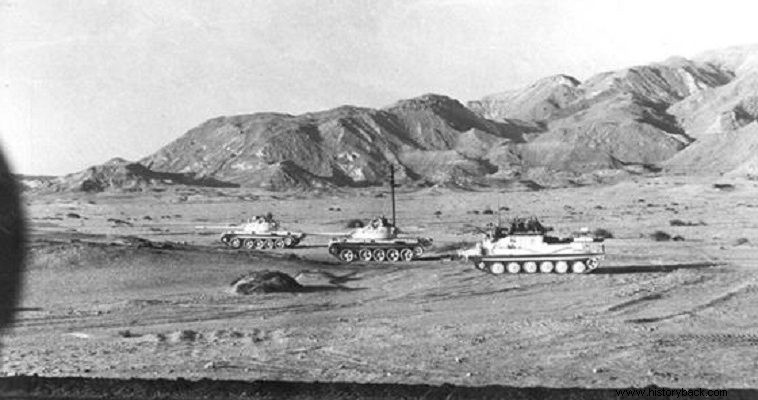
Operation Drizzle is the perfect example of a commando operation inside enemy territory. The Israelis invaded, hit and left destroying not only their targets but mostly the morale of their opponents.
In 1967, Israel launched a surprise attack against its Arab rivals, inflicting terrible blows on them (Six Day War). Nevertheless, Nasser's Egypt did not accept its defeat and for about three years an undeclared war (War of Attrition) continued between Israelis and Egyptians.
Clashes were frequent mainly in the air and with Soviet participation in favor of the Egyptians. But the Israelis decided to push things by launching a raid deep into Egyptian territory west of the Suez Canal.
The operation was jointly planned by the Armored Command and the Israel Navy. Command was assigned to lieutenant colonel Baruch Harel. The operation would be carried out by Israeli units with captured Egyptian tanks, vehicles and uniforms.
Thus, six T-55 tanks and three BTR-50 armored personnel carriers (APVs) were collected from the spoils. Each tank would be commanded by an officer, while their crews are made up of experienced members of the Israeli army's armored school.
The infantrymen on board the TOMBs belonged to the reconnaissance company of the 7th Armored Brigade, having with them men of the famous Sayaret Matkal (Unit 269), connoisseurs of the Arabic language.
The passage of the canal would be carried out by landing craft of the 11th Stolisk of the navy, while the landing on the Egyptian coast would be preceded by a reconnaissance by men of Shayetet 13 , of the Israeli UK, way tina.
The participants underwent intensive and arduous training for six weeks and finally, in early September 1969, under conditions of utmost secrecy, the raiding force was assembled at Ras Shudar, in the Sinai Peninsula.
Audacious Raid
On 7 September eight Shayetet 13 commandos crossed the Egyptian coast at Ras Sadat and blow up two Egyptian torpedo boats which could attack Israeli landing sites. However, the attack also aimed to draw the attention of the Egyptians to that point, at the time when the Israeli invasion force would land further south.
Meanwhile Harel's small force (about 100 men) landed unmolested at 03:37 am at el Hafeir, 40 km south of Ras Sadat. Tanks and TOMs carried additional fuel and ammunition. The Israelis disguised as Egyptians moved south spreading panic in their wake.
Initially they attacked an Egyptian air force base and a radar station at Abu Darag, neutralizing both by surprise. At daybreak the small Israeli force was supported by air from A-4 Skyhawk attack aircraft, one of which was shot down.
Harel's force destroyed yet another radar station at Ras Saafranah. The Harel force destroyed 19 Egyptian coastal positions, 12 more Egyptian outposts before it was detected and heavy Egyptian armored forces were sent against it.
The Israelis then decided that the time had come to leave. After blowing up the routes by which the enemy could approach them, operating for over 9 hours inside enemy territory, they signaled the 11th Flotilla to pick them up at Ras Saafranah.
The Israeli force crossed the Sinai Peninsula without problem, having neutralized about 200 enemy men, destroyed two radar stations and killed a Soviet officer, military advisor of the Egyptian forces (Colonel Korneev) . Israeli sources report the death of another Soviet adviser (Karasev) and an Egyptian senior or top officer.
All this cost one dead pilot, three dead men of Shayetet 13 and one wounded member of Harel's force.
Commotion
News of the brazen Israeli raid soon reached Cairo. On hearing them, Egyptian President Nasser suffered a heart attack. As soon as he came to his senses, however, he "discharged" the chief of the army and navy, General Ahmed Ismail Ali and Fuad Abu Zikri, respectively, the military commander of the Red Sea region and a number of other officers... A year later, Nasser died.
In response, on September 11, Egypt launched a massive 102-aircraft strike against Israeli positions in the Sinai, losing eight (11 according to other sources) aircraft to one Israeli. To boost the battered Egyptian morale, Cairo admitted the raid, but announced that "the attackers" had been repulsed with heavy losses."
